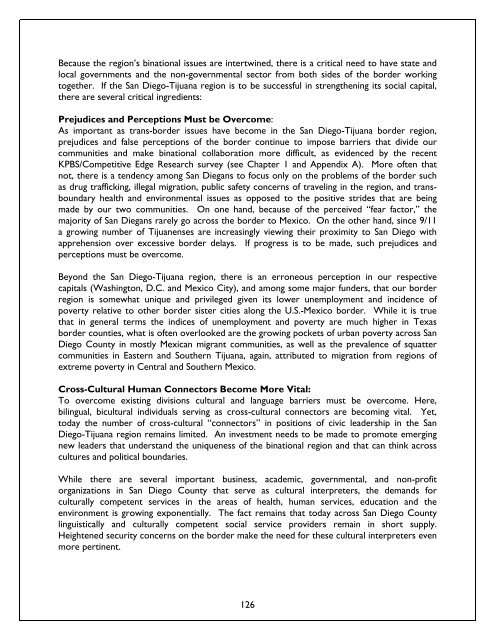Blurred Borders - International Community Foundation
Blurred Borders - International Community Foundation
Blurred Borders - International Community Foundation
You also want an ePaper? Increase the reach of your titles
YUMPU automatically turns print PDFs into web optimized ePapers that Google loves.
Because the region’s binational issues are intertwined, there is a critical need to have state and<br />
local governments and the non-governmental sector from both sides of the border working<br />
together. If the San Diego-Tijuana region is to be successful in strengthening its social capital,<br />
there are several critical ingredients:<br />
Prejudices and Perceptions Must be Overcome:<br />
As important as trans-border issues have become in the San Diego-Tijuana border region,<br />
prejudices and false perceptions of the border continue to impose barriers that divide our<br />
communities and make binational collaboration more difficult, as evidenced by the recent<br />
KPBS/Competitive Edge Research survey (see Chapter 1 and Appendix A). More often that<br />
not, there is a tendency among San Diegans to focus only on the problems of the border such<br />
as drug trafficking, illegal migration, public safety concerns of traveling in the region, and transboundary<br />
health and environmental issues as opposed to the positive strides that are being<br />
made by our two communities. On one hand, because of the perceived “fear factor,” the<br />
majority of San Diegans rarely go across the border to Mexico. On the other hand, since 9/11<br />
a growing number of Tijuanenses are increasingly viewing their proximity to San Diego with<br />
apprehension over excessive border delays. If progress is to be made, such prejudices and<br />
perceptions must be overcome.<br />
Beyond the San Diego-Tijuana region, there is an erroneous perception in our respective<br />
capitals (Washington, D.C. and Mexico City), and among some major funders, that our border<br />
region is somewhat unique and privileged given its lower unemployment and incidence of<br />
poverty relative to other border sister cities along the U.S.-Mexico border. While it is true<br />
that in general terms the indices of unemployment and poverty are much higher in Texas<br />
border counties, what is often overlooked are the growing pockets of urban poverty across San<br />
Diego County in mostly Mexican migrant communities, as well as the prevalence of squatter<br />
communities in Eastern and Southern Tijuana, again, attributed to migration from regions of<br />
extreme poverty in Central and Southern Mexico.<br />
Cross-Cultural Human Connectors Become More Vital:<br />
To overcome existing divisions cultural and language barriers must be overcome. Here,<br />
bilingual, bicultural individuals serving as cross-cultural connectors are becoming vital. Yet,<br />
today the number of cross-cultural “connectors” in positions of civic leadership in the San<br />
Diego-Tijuana region remains limited. An investment needs to be made to promote emerging<br />
new leaders that understand the uniqueness of the binational region and that can think across<br />
cultures and political boundaries.<br />
While there are several important business, academic, governmental, and non-profit<br />
organizations in San Diego County that serve as cultural interpreters, the demands for<br />
culturally competent services in the areas of health, human services, education and the<br />
environment is growing exponentially. The fact remains that today across San Diego County<br />
linguistically and culturally competent social service providers remain in short supply.<br />
Heightened security concerns on the border make the need for these cultural interpreters even<br />
more pertinent.<br />
126















